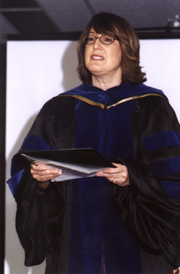
Sandra Weber in her academic robe
Photo by Caroline
Bureau
|
by James Martin
On the first day of February, Sandra Weber disrobed for a small yet appreciative
audience.
The performance was a work-in-progress titled “Robe to Robe: Dressing
the Academic Body,” an engaging monologue which mixed theory and
autobiography.
Dr. Weber is Professor of Education at Concordia, a fellow of the Simone
de Beauvoir Institute, and a staunch believer that “narrative —
including autobiography — and photography and art are forms of inquiry
undervalued by some scholars. Through metaphor and imagery, narratives
pose multi-layered theoretical statements that are not only elegant, but
often are directly applicable to practice.”
Weber has been conducting narrative research, much of it autobiographical,
for over 20 years. The interest dates back to her studies at the University
of Alberta, where visiting scholars (including Paulo Freire, Michael Apple,
Eliot Eisner, and Maxine Greene) inspired Weber to explore the possibilities
of “literary and arts-based methods of inquiries.”
“They exposed me to a lot of the ongoing debates about how to theorize
the relationship between the social and the personal,” she recalls,
“a relationship which I have come to view as dialectic and ever-changing.
“I am fascinated by the impossible challenges we face in trying to
include the social and the personal, the global and the local in our scholarly
methods and deliberations. My interest in autobiographical performance
is part of a larger commitment to refining methods of inquiry and modes
of representation for the social sciences that draw on well-developed
approaches and genres more commonly used in the humanities and the arts.
“A skillfully crafted narrative contains numerous points of connection
with the reader or audience that can evoke shared elements of contextualized
human experience, and provoke multiple interpretations that lead to reflections
or ways of re-thinking the everyday.”
All of which goes to explain why Weber found herself wearing her PhD gown
(University of Alberta, circa 1985) in front of curious strangers.
“This is my academic robe,” she began by way of introduction.
“It usually hangs somewhere in the back of a closet — dusty,
seldom used, and out of sight.”
Weber ruminated upon this most formal of body coverings. She speculated
on viable options for undergarments, concluding that, despite the heat
of stage lights, “robed nudity is not an option.” Having taught
at three universities, Weber drew upon years of eavesdropping to conjure
a humourous peanut gallery of whispered convocation commentary:
“Sandals and green toenail polish — that’s no way for a
professor to dress for convocation!”
“What a lovely gown his university has! I wish my degree was from
there.”
“Sequins before noon. Whatever is that girl thinking?”
Pseudo-cattiness gave way to musings on the role of the robe. Is it a
democratic uniform? An end run around carnal distractions from deep thought?
A relic of bygone elitism? Symbolic protection, lest the ivory tower become
sullied by the grime of the world?
“Whatever their function,” she said, “or whatever meaning
we wish to attribute to them, academic robes are costly to dry clean,
cumbersome to carry, and not nearly as silky and comfy as the robe I choose
so readily to wear at home —”
And that’s when she disrobed, revealing. . . a colourful, comfortable
bathrobe.
“This is the sort of scholarly uniform I wear as I hunch over my
computer keyboard for hours on end, writing an article or a report, or
preparing a course syllabus.”
In the blink of an eye (a somewhat extended blink, actually, as Weber’s
double-knotted academic robe caused unexpected delay), Weber deftly segued
into the domesticity of pedagogy. She spoke of how her bathrobe “gradually
and imperceptibly becomes a ritual wrestling robe, as I struggle with
ideas and my own inability to find the right words,” of the intimate
act of grading student papers in her own home, of her reluctant acceptance
of the “maternal curve to my pedagogic stance.”
And then, with the declaration that it was time “to clothe this embodied
mind, this mindful body,” Weber removed her bathrobe to reveal a
simple black dress: “It’s time to go outside.”
“Robe to Robe” is part of “Mindful Bodies, Embodied Minds,”
an ongoing project in which Weber and frequent collaborator Claudia Mitchell
examine the significance of clothes and the body to professional identity
and teaching. (Mitchell and Weber are also co-editors of the forthcoming
Not Just Any Dress: Explorations of Dress, Identity, and the Body Across
the Life-Span.)
Those who missed the “dress” rehearsal can catch “Robe
to Robe” this May at the Canadian Association for Studies on Women
in Education conference in Toronto.
|
|
|



